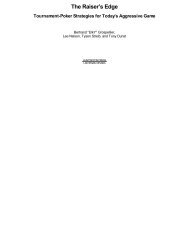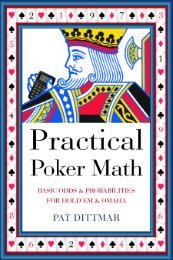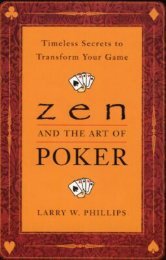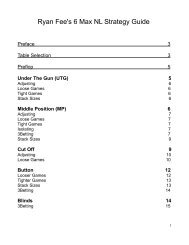You also want an ePaper? Increase the reach of your titles
YUMPU automatically turns print PDFs into web optimized ePapers that Google loves.
62<br />
We have a flush draw. The pot is $25. Our opponent has $24<br />
left in his stack, and we have him covered. He’s first to act and<br />
goes all-in. Do we call or fold? We can do this problem right at<br />
the table in just a couple seconds. Let’s look at our pot odds. He<br />
bet almost the pot. So, from memorizing our chart, we know<br />
we’ve got to be good about 33%. Now, how often will we win?<br />
We count our outs and see we have nine outs to win. Using our<br />
4/2 rule, we multiple our 9 outs times 4 (since we’re all-in on the<br />
flop) and come up with 36%. This is greater than the 33% we<br />
need, so we should call. Not too bad, right?<br />
Although it may seem cumbersome now, you will become very<br />
quick with this after some practice. You could run an EV<br />
calculation to check the EV of this call when you’re away from<br />
the table. Realize in the wager, when we win, we’ll win $49.<br />
This is $25 in the pot, and our opponent’s $24 bet. When we<br />
lose, we’ll lose the $24 we put in to call.<br />
0.36($49) - 0.64($24) = EV<br />
$17.64 – $15.36 = $2.28<br />
I do want to show you an alternate way to calculate your EV.<br />
This way you can use whichever method you like the best. We<br />
can multiply the total pot after we call by the probability we’ll<br />
win it. Then we subtract what we had to call.<br />
0.36($73) – $24 = EV<br />
$26.28 - $24 = $2.28<br />
So, with this call our EV is $2.28









